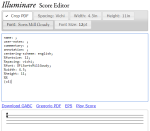Main Page
This website contains 101 pages and 60 sheet music files in JPG and PDF format to use and download.
Famous quotes:
"We do not sing because we are happy; we are happy because we sing. (William James)"
Latest entries
Info & Utility
Antiphonae
Introitum
Hymnus
Tractus
The Tract (in Latin Tractus, in Ambrosian chant Cantus) is a liturgical chant between the readings, which belongs to the Proper of the Mass. In the Tridentine Mass it replaces the Alleluia verse during Lent, during the Season of Septuagesima, and in Masses for the dead. After the liturgical reform of the Roman rite in 1969, in the acclamation before the Gospel, one may sing instead of the Alleluia during Lent either the verse placed in the Lectionary before the Gospel, or another psalm or a tract as found in the Gradual[1].
Graduals - Gradualia
The gradual, formerly called Responsorium Graduale, is a melismatic inter-lecture chant that belongs to the proper of the Mass. Its name derives from the Latin gradus, step, because originally the singers sang the gradual while remaining on the steps of the ambo.
In the current liturgical order of the Roman rite, it can be sung after the first reading, using the Gregorian or polyphonic repertoire, with the function of an invitation to meditate on the Word heard. More frequently the gradual is not sung and is then replaced by the responsorial psalm prescribed by the missal. During Easter time the gradual is not contemplated, another alleluia chant is performed in its place, with the exception of the octave of Easter.
Psalms - Psalmus
Alleluia - Versus alleluiatici
Sequentia
The sequence, often also called by its Latin name sequentia, is a liturgical musical poetic composition that is recited (or sung) at the end of the second reading while the assembly remains seated until its end and at the Alleluia that acclaims the Gospel one stands up.
The sequence belongs to the proper of the mass: its text therefore varies according to the liturgical occasion celebrated.
Offertorium
Communio
Cantus in Ordine Missae Occurrentes
Kyriale
Cantus in Ordine Missae Occurrentes
Toni Communes
This section of the site contains the common tones for the parts of the Mass in Gregorian chant, according to the Graduale Romanum/Triplex 1974/1979.
I - AD RITUS INITIALES
- In nomine Patris (Signum Crucis)
- Formula salutationis I
- Formula salutationis II
- Formula salutationis III
II - PRO ORATIONIBUS
III - AD LITURGIAM VERBI
Toni Lectionum
Toni evangelii
IV - AD PRECEM EUCHARISTICAM
Ante praefationem
- Dominus vobiscum - Ante praefationes (Tonus Simplex)
- Dominus vobiscum - Ante praefationes (Tonus Sollemnis)
Post consecrationem
Ad doxologiam
V - AD RITUS COMMUNIONIS
Tonus embolismi et ad pacem
VI. AD RITUS CONCLUSIONIS
Ad benedictionem simplicem
Ad benedictionem sollemn
et orationes super populum
Ad benedictionem episcopalem
Ad dimittendum populum
VII. TONI V. GLORIA PATRI PRO ANTIPHONIS AD INTROITUM ET AD COMMUNIONEM
- I Tono Gloria Patri (Introitus et Communionis)[2]
- II Tono Gloria Patri (Introitus et Communionis)[2]
- III Tono Gloria Patri (Introitus et Communionis)[2]
- IV Tono Gloria Patri (Introitus et Communionis)[2]
- V Tono Gloria Patri (Introitus et Communionis)[2]
- VI Tono Gloria Patri (Introitus et Communionis)[2]
- VII Tono Gloria Patri (Introitus et Communionis)[2]
- VIII Tono Gloria Patri (Introitus et Communionis)[2]
Responsoria
The responsory is the chant that follows the reading in the liturgy of the hours of the Catholic Church. The name of responsory traditionally given to this piece, testifies to its original form of responsorial psalmody where the schola sang a psalm or a canticle and the assembly responded by singing an antiphon after each verse. Its evolved form, still in use today, does not fully reflect its authenticity of the roles between the soloist and the people, the number of verses has been significantly reduced and a final doxology has been added (Gloria Patri et Filio et Spiritui Sancto).
There are two types of responsory:
- responsorium breve, very short in its current form and of an extremely simpler character and suitable for the daily office.
- responsorium prolixum, used in the nocturne after each lesson. It is distinguished from the short responsory by its prolixity, both of text and melody. In the repertoire of Gregorian chant, nine prolix responsories of the Roman office and twelve of the monastic office are known.
Alphabetical Index of the chants present
Chants during the Liturgical Year[3]
Booklets for Feasts and Solemnities[4]
- Missa Pro Defunctis - with Sequentia Dies irae
- Christmas Night Mass
- Christmas Day Mass
- Mass for the Solemnity of Saints Peter and Paul (June 29)
- Assumption of the B.V.M. (August 15) - Mass of the day
- Mass for the Feast of St. Bartholomew the Apostle (August 24)
- Mass of the Solemnity of Saint Francis of Assisi (October 4)
Liturgia Horarum
This section of the site contains the common tones, responsories, hymns and antiphons of the Liturgy of the Hours in Gregorian chant, according to the latest published volumes (Antiphonale Romanum I and II, Antiphonale Monasticum I of 2005).
Toni Communes
Ad ritum initialem
- Domine, labia mea aperies (Tonus ferialis)
- Domine, labia mea aperies (Tonus festivus)
- Deus, in adiutorium meum (ferialis, dominicis et festis)[5]
- Deus, in adiutorium meum (In solemnitatibus)[5]
De cantu psalmorum
- Tonus Psalmorum I[5]
- Tonus Psalmorum II[5]
- Tonus Psalmorum II*[5]
- Tonus Psalmorum III[5]
- Tonus Psalmorum IV[5]
- Tonus Psalmorum IV*[5]
- Tonus Psalmorum V[5]
- Tonus Psalmorum VI[5]
- Tonus Psalmorum VII[5]
- Tonus Psalmorum VIII[5]
- Tonus Psalmorum Peregrinus[5]
Ad Completorium
Documents and Books
The Gregorian Chant
Trattazioni:
Downloadable Gregorian Chant Books - Official Editions::
Downloadable Gregorian Chant Books - Complementary Editions:
Sacred Music and the Liturgy
Gregorian Chant Books to Buy (Solesmes Abbey)
Note
- ↑ General Instruction of the Roman Missal. Link: https://www.vatican.va/roman_curia/congregations/ccdds/documents/rc_con_ccdds_doc_20030317_ordinamento-messale_it.html
- ↑ 2.0 2.1 2.2 2.3 2.4 2.5 2.6 2.7 Cite error: Invalid
<ref>tag; no text was provided for refs namedgradualeromanum75 - ↑ The list is not exhaustive and is continuously updated.
- ↑ The list is not exhaustive and is continuously updated.
- ↑ 5.00 5.01 5.02 5.03 5.04 5.05 5.06 5.07 5.08 5.09 5.10 5.11 5.12 5.13 Antiphonale Romanum II, 2005











